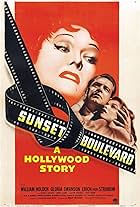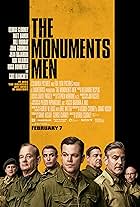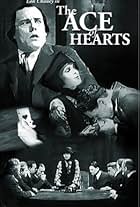
CJBx7
Joined Jul 2013
Welcome to the new profile
We're still working on updating some profile features. To see the badges, ratings breakdowns, and polls for this profile, please go to the previous version.
Ratings172
CJBx7's rating
Reviews53
CJBx7's rating
Mary Denby (Cleo Ridgely), a seamstress from the slums, gets a chance at a better life when she is employed by a couple that hopes to woo a young millionaire (Wallace Reid) into a lucrative contract. However, unbeknownst to her employers and would-be-suitor, she has a thieving drunkard husband (Horace B Carpenter) who complicates things. Directed by Cecil B DeMille.
The story is generally engaging, although at times somewhat implausible, and with a rather rushed ending. Cleo Ridgely is quite appealing and sympathetic as the heroine, and Wallace Reid smolders and charms very effectively as the debonair millionaire. The acting by all is generally quite restrained and naturalistic, showing that even in the early days of feature films actors were capable of nuanced performances.
Director Cecil B DeMille and cinematographer Alvin Wyckoff make a very talented team, imbuing the film with distinctive lighting and shadow effects, as well as intriguing compositions (note the shot where Reid and Ridgeley kiss, which is done with the camera looking down briefly from above). By now they had emerged with a distinctive style, consolidating the successful elements at work in CARMEN and THE CHEAT (which also came out in 1915). A nice film, worth watching for silent movie enthusiasts as well as those who may be new to silent film. SCORE: 8/10.
The story is generally engaging, although at times somewhat implausible, and with a rather rushed ending. Cleo Ridgely is quite appealing and sympathetic as the heroine, and Wallace Reid smolders and charms very effectively as the debonair millionaire. The acting by all is generally quite restrained and naturalistic, showing that even in the early days of feature films actors were capable of nuanced performances.
Director Cecil B DeMille and cinematographer Alvin Wyckoff make a very talented team, imbuing the film with distinctive lighting and shadow effects, as well as intriguing compositions (note the shot where Reid and Ridgeley kiss, which is done with the camera looking down briefly from above). By now they had emerged with a distinctive style, consolidating the successful elements at work in CARMEN and THE CHEAT (which also came out in 1915). A nice film, worth watching for silent movie enthusiasts as well as those who may be new to silent film. SCORE: 8/10.
Helpful•10
Directed by Sidney Franklin. Norma Talmadge and Ralph Lewis star in GOING STRAIGHT (1916). A well-to- do couple, the Remingtons, happily raise their children in the suburbs of New York, but there is a secret from their past that threatens to destroy their happiness. Years before, both of them were involved in a gang of thieves. The husband served his sentence but the wife never got time. Years later, a member of the gang, Dan Briggs, runs into Mr Remington and blackmails him. How far will they go to make sure their past doesn't destroy their future?
This film was quite brisk and economical in its pacing. The plot takes some intriguing turns and presents the characters with difficult decisions. It plays a bit more like a modern movie - the story of a couple who have a past that threatens to surface is one that has been used more in recent films than in the silent era. One can feel sympathy for the central couple, and the narrative features enough layers to keep things interesting.
Norma Talmadge is very good as Grace Remington, acting with a nuanced naturalism that is quite remarkable. Where many actresses of the time would have done lots of clutching and bug-eyed gestures, Talmadge conveys her character's trepidation with the utmost realism. She uses her large expressive eyes to memorable effect, and gives a solid performance. Ralph Lewis is effective in his role as a husband striving to protect his family. He and Norma Talmadge have good chemistry together despite the obvious age difference. Perhaps most memorable of all was Eugene Palette in his role as the menacing Briggs. His body language, appearance, and overall air of criminal decadence seems like a foreshadowing of Robert Mitchum's performance in CAPE FEAR (1962). Palltte makes an unforgettable heavy, just shifty enough without overplaying. Child actor Georgie Stone is also charming and distiguished as Jimmy, a street waif whom Briggs uses for his schemes, but who finds a sweet and convincing rapport with the Remington children.
The direction was quite good, and the editing and cinematography were quite accomplished. There are some interesting touches, like near the end where Remington sees Briggs entering his house - this is conveyed through a reflection on the windows of a china cabinet. Norma Talmadge is given a number of expressive close-ups. Tinting is used effectively as well. One can see some of the influence of Cecil B DeMille in the use of light and shadow. Overall, the movie is visually striking.
My wife and I watched this film. She is not as into silent movies as I am, but has been good enough to watch them with me on occasion. She felt that the movie was quite interesting. In my opinion this would be a good picture to introduce newcomers to the world of silent film. Many have the idea of silents as hokey films with overly fast movement and acting of the stagger-and-clutch variety. This film would help to clear up misconceptions about silent movies and may fuel more interest in cinema of this period.
GOING STRAIGHT is an excellent film, featuring an interesting plot, memorable and nuanced performances, and accomplished cinematography and direction. Definitely worth checking out for silent movie fans, and even if you're not one, you may find it entertaining. SCORE: 8/10
This film was quite brisk and economical in its pacing. The plot takes some intriguing turns and presents the characters with difficult decisions. It plays a bit more like a modern movie - the story of a couple who have a past that threatens to surface is one that has been used more in recent films than in the silent era. One can feel sympathy for the central couple, and the narrative features enough layers to keep things interesting.
Norma Talmadge is very good as Grace Remington, acting with a nuanced naturalism that is quite remarkable. Where many actresses of the time would have done lots of clutching and bug-eyed gestures, Talmadge conveys her character's trepidation with the utmost realism. She uses her large expressive eyes to memorable effect, and gives a solid performance. Ralph Lewis is effective in his role as a husband striving to protect his family. He and Norma Talmadge have good chemistry together despite the obvious age difference. Perhaps most memorable of all was Eugene Palette in his role as the menacing Briggs. His body language, appearance, and overall air of criminal decadence seems like a foreshadowing of Robert Mitchum's performance in CAPE FEAR (1962). Palltte makes an unforgettable heavy, just shifty enough without overplaying. Child actor Georgie Stone is also charming and distiguished as Jimmy, a street waif whom Briggs uses for his schemes, but who finds a sweet and convincing rapport with the Remington children.
The direction was quite good, and the editing and cinematography were quite accomplished. There are some interesting touches, like near the end where Remington sees Briggs entering his house - this is conveyed through a reflection on the windows of a china cabinet. Norma Talmadge is given a number of expressive close-ups. Tinting is used effectively as well. One can see some of the influence of Cecil B DeMille in the use of light and shadow. Overall, the movie is visually striking.
My wife and I watched this film. She is not as into silent movies as I am, but has been good enough to watch them with me on occasion. She felt that the movie was quite interesting. In my opinion this would be a good picture to introduce newcomers to the world of silent film. Many have the idea of silents as hokey films with overly fast movement and acting of the stagger-and-clutch variety. This film would help to clear up misconceptions about silent movies and may fuel more interest in cinema of this period.
GOING STRAIGHT is an excellent film, featuring an interesting plot, memorable and nuanced performances, and accomplished cinematography and direction. Definitely worth checking out for silent movie fans, and even if you're not one, you may find it entertaining. SCORE: 8/10
Helpful•20
Mary Pickford stars as Gwendolyn, an 11 year old who longs for the love of her wealthy parents, but has only the servants for company. Her attempts to find friendship and ease her loneliness lead to comic and touching situations. This vehicle was one of the highest grossing films of 1917 and consolidated Mary Pickford's stardom even further.
Frances Marion contributes a fine screenplay. Gwendolyn is an appealing character - she's not flawless, but she is very sympathetic. Mischievous, spunky and resourceful, yet also longing for love and tenderness, she is a memorable heroine. There are plenty of comic moments, like when Gwendolyn invites the organ grinder into the house, a mud-pie fight with neighborhood boys, her escapades in the bathroom, etc. And there are touching moments as well, such as Gwendolyn's visit to her father's office, and Gwendolyn's battle for life after an irresponsible servant gives her a poisonous sleeping medicine. A dream sequence near the end, while a bit lengthy for my taste, astutely plays on the movie's themes and shows a surreal child's-eye view of things in a delightful way.
Mary Pickford is very charming and believable. I had my reservations about watching Pickford, who was then about 24 years old, playing an 11 year old girl, but when she came on screen I was hooked right away. It's easy to see why she was such a big star - she is utterly charismatic, natural, spunky and witty, tender and moving, with a distinctive, luminous beauty. Charles Wellesley and Madlaine Traverse contribute fine support as Gwendolyn's parents. Wellesley is especially good in the scenes where he interacts with Pickford's character; he conveys a father who wants to reach out to his daughter yet is hesitant to do so. Gladys Fairbanks is fine as Jane, a domestic worker who has the unenviable job of trying to rein in the free-spirited Gwendolyn.
Maurice Tourneur, one of the most acclaimed directors of early cinema, makes this film a beautiful viewing experience. The restored copy I watched displayed beautiful tinting, moody, expressive shadows, and Tourneur's use of space to emphasize Gwendolyn's loneliness. The editing is seamless and no shots linger too long, showing the advancement that cinema had made since the beginning of the feature era five years before.
Overall, POOR LITTLE RICH GIRL is a classic of its era that has stood the test of time very well. The fine acting, beautiful cinematography, and poignant story make it worth watching. SCORE: 9/10
Frances Marion contributes a fine screenplay. Gwendolyn is an appealing character - she's not flawless, but she is very sympathetic. Mischievous, spunky and resourceful, yet also longing for love and tenderness, she is a memorable heroine. There are plenty of comic moments, like when Gwendolyn invites the organ grinder into the house, a mud-pie fight with neighborhood boys, her escapades in the bathroom, etc. And there are touching moments as well, such as Gwendolyn's visit to her father's office, and Gwendolyn's battle for life after an irresponsible servant gives her a poisonous sleeping medicine. A dream sequence near the end, while a bit lengthy for my taste, astutely plays on the movie's themes and shows a surreal child's-eye view of things in a delightful way.
Mary Pickford is very charming and believable. I had my reservations about watching Pickford, who was then about 24 years old, playing an 11 year old girl, but when she came on screen I was hooked right away. It's easy to see why she was such a big star - she is utterly charismatic, natural, spunky and witty, tender and moving, with a distinctive, luminous beauty. Charles Wellesley and Madlaine Traverse contribute fine support as Gwendolyn's parents. Wellesley is especially good in the scenes where he interacts with Pickford's character; he conveys a father who wants to reach out to his daughter yet is hesitant to do so. Gladys Fairbanks is fine as Jane, a domestic worker who has the unenviable job of trying to rein in the free-spirited Gwendolyn.
Maurice Tourneur, one of the most acclaimed directors of early cinema, makes this film a beautiful viewing experience. The restored copy I watched displayed beautiful tinting, moody, expressive shadows, and Tourneur's use of space to emphasize Gwendolyn's loneliness. The editing is seamless and no shots linger too long, showing the advancement that cinema had made since the beginning of the feature era five years before.
Overall, POOR LITTLE RICH GIRL is a classic of its era that has stood the test of time very well. The fine acting, beautiful cinematography, and poignant story make it worth watching. SCORE: 9/10
Helpful•20

























